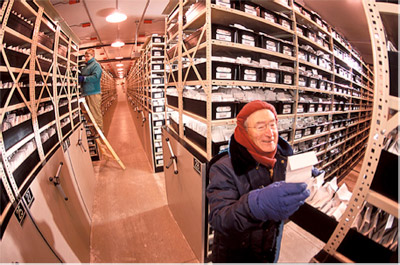This post is part of the Science Tuesday feature series on the USDA blog. Check back each week as we showcase stories and news from the USDA's rich science and research portfolio.
If you’re a gardener, you’re probably starting to think about picking up some seeds for this year’s garden. Perhaps you’re digging out those seeds you scooped out of last year’s pumpkin, or setting up a mini-greenhouse to get a head start on planting. Have you ever wondered where the seeds at your local garden center came from? It probably wasn’t the side of a volcano in Far East Russia, but you never know.
In 2003, USDA researchers partnered with scientists at Russia’s Vavilov Institute of Plant Industry to collect samples of a rare wild strawberry (Fragaria iturupensis) from the Atsunupuri Volcano, on the island of Iturup. Samples of the seed were sent to a USDA lab in Corvallis, OR, for study; the strawberry may provide new flavor components or pest resistance that can be bred into commercial strawberry lines.
But what happens if those samples get damaged or destroyed? Seeds are an important part of our agricultural future; without a well-maintained stock of seeds, our future food supply would dry up. Fortunately, USDA scientists thought of this long ago and have been collecting and cataloging germplasm since 1898. In cooperation with state agricultural experiment stations and universities, the USDA keeps hundreds of collections of plants, seeds, trees, microbes, cell cultures, and even insects. These collections protect the future of agriculture by preserving the genetic diversity necessary for a plant or animal to adapt to changing growth conditions. If you knew that a certain type of tomato just didn’t do well in your garden, you probably wouldn’t try to grow it year after year without making some changes. The same is true for crops grown in fields. The collections also preserve our history; one collection in Oregon contains genetic material from the oldest living pear tree in the United States. It’s all part of the USDA’s commitment to seed preservation.

Last month, USDA scientists sent some 10,000 seed samples for storage in the Svalbard Global Seed Vault (SGSV) in Norway. February’s shipment marks the third such shipment of seed lines to the vault. SGSV stores seeds of everything from soybeans, wheat, rice, carrot, and sorghum to sunflowers, bananas and wild strawberries that only grow in Far East Russia. Svalbard now contains about 45,000 of the USDA’s 511,000 seeds, tissue samples, and whole plants; plans are to have the majority of them backed up at Svalbard in the next 10 to 15 years.
Think of Svalbard as agriculture’s Noah’s Ark. About 1,400 seed banks worldwide already house the seeds that ensure our food supply, but if one of those locations suffered a natural disaster and didn’t have electricity for a month, those seeds could be lost. Svalbard’s backup seeds could then be used to re-establish those lines.
The storage chambers at Svalbard are buried deep in the permafrost on the side of a mountain, on a Norwegian island 800 miles from the North Pole. Spitsbergen Island’s subarctic location makes it a secure, if chilly, location to house the seeds. The cold keeps the seeds in slumber mode, and the island’s location, far from any tectonic plate boundary, means that no earthquakes or volcanic activity will disturb the vault. It’s high enough in the mountains that the vault will stay dry even if the sea level rises 400 feet. And the polar bears will probably discourage any intruders.
USDA’s germplasm collections grow each year thanks to worldwide collaborations and gathering expeditions—without which, we’d never have a strawberry plucked from the side of a volcano in Russia. With this catalog of genetic diversity at our fingertips, we can keep agriculture’s past alive and ensure its future.
Ellen Buckley, Program Analyst, Natural Resources and Sustainable Agricultural Systems, USDA Agricultural Research Service
